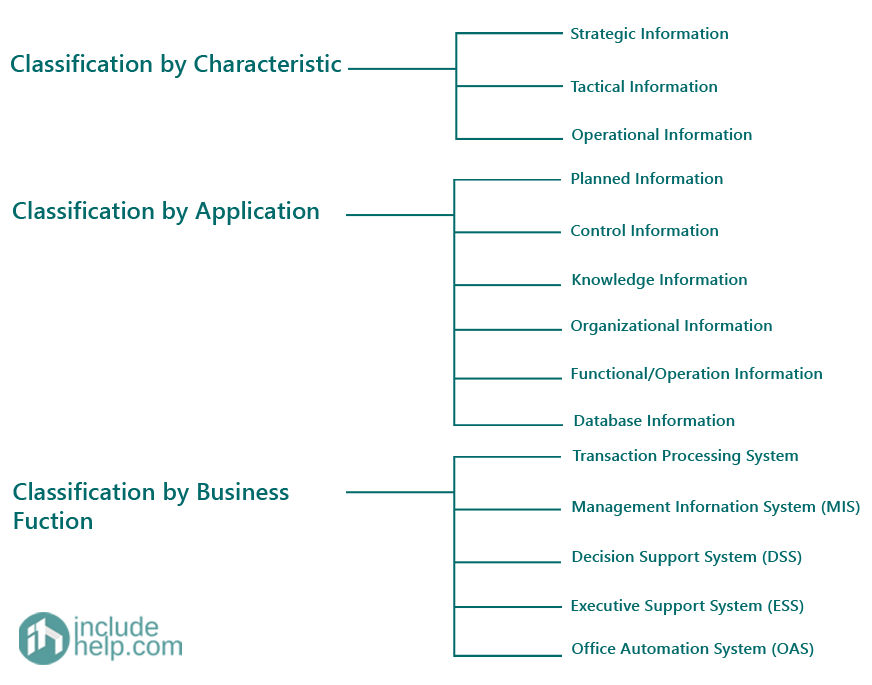Home »
Management Information System
Classification of MIS
MIS | Classification: In this tutorial, we will learn about the various classification of Management Information System (MIS) based on information characteristics, applications, and business functions.
By IncludeHelp Last updated : June 01, 2023
MIS classification is a broad concept; this article facilitates you to have a crystal clear understanding about the MIS classification. Here, we categories MIS into three main categories, these are,
- Classification as per Information Characteristics
- Classification as per Application
- Classification as per Business Function
The below image is depicting about the classification with its sub categories,

1) Classification as per Information Characteristics
Based on Anthony's brand of Management, information that is used in commerce trade for decision-making is generally categorized into three types:
- Strategic Information: Strategic information deals with an objective of a house with long-term policy decisions as well as checks provided these objectives are met up to their level or not. For example, acquiring the new plant, the new product, diversification of chain, etc, comes under strategic information.
- Tactical Information: Tactical information deals with the information needed to rule over business resources, like budgeting, bracket control, improvement level, stock level, productivity level, etc.
- Operational Information: Operational information deals with plant/business level information as well as is used to handle proper conduction of specific operational tasks as planned/intended. Various operators specific, machine-specific as well as shift particular jobs for quality authority checks come under this category.
2) Classification as per Application
- Planned Information: This is the information used in business organizations maintaining specification norms and specifications. Everything is mentioned here. This information is used in the strategic, tactical, and operation planning of any activity. Examples of such information are time standards, design standards.
- Control Information: This information is termed for specific activities performed by the system in design to attain their objectives. This information might cost formal or informal. It is used for controlling attainment, line, and utilization of important processes in a system. When this information did make-up any deviation from the defining standards, the system should be imposing a decision or an action main to authority the information related to their objectives.
- Knowledge Information: cognition is defined as "information about information". Knowledge information is acquired through experience and learning and collected from archival data and research studies.
- Organizational Information: Organizational information deals with an organization's environment, where organizational objectives are met. Karl Weick's Organizational Information theory emphasizes that a company reduces its uncertainty by collecting, managing, and using this information carefully. This information is used by everybody in the organization; examples of such information are employee and payroll information.
- Functional/Operational Information: This is operation-specific information where the organization assists to perform its functions of day-day transactions. Mainly preserves technical make-up, For example, daily schedules in a manufacturing plant that indicated the detailed assignment of jobs to machines or machines to operators. In a value-oriented business, it would constitute the duty roster of various personnel. This information is mostly internal to the organization.
- Database Information: Database information as we know that it is a collection of related data that is stored, retrieved, and managed to name databases. It stores large quantities of information that has multiple ownership and application. For example, the tangible substance that goes into the makeup of physical thing specification or supplier information is stored for multiple users. It is a type of software program.
3) Classification as per Business Function
An individual who is employed in or trained for a job is referred to as a businessperson. Systems: These systems are one of the leading types of knowledge-based information systems. These systems are based on artificial intelligence, and are contemporary information systems. A business professional system is a strategic based information system that uses its strategic about a specific, complex application area to act as an expert. The main components of a professional system are:
- Knowledge Base
- Interface Engine
- User Interface